Comprehensive Auditing Report: Woolworths Ltd Financial Analysis
VerifiedAdded on 2023/03/23
|20
|4370
|22
Report
AI Summary
This report provides a comprehensive auditing analysis of Woolworths Ltd, a leading supermarket chain in Australia. It begins with an introduction outlining the report's purpose: to analyze the company's business from an audit perspective. The report delves into the background and industry analysis, highlighting the competitive pressures, liquidity conditions, and regulatory risks faced by the business. It then proceeds to analyze the financial statements, examining the profit and loss statement and balance sheet, and discussing potential misstatements in key accounts like sales, cost of sales, and inventory. The report further applies the audit risk model to assess inherent, control, and detection risks. An analytical review of the business involves computation of key financial ratios. Estimation of planning materiality is also discussed, followed by an examination of audit assertions and planning for various accounts, including cash, inventory, and sales. The report concludes with a discussion of audit work steps and sampling plans for each account, ensuring a thorough audit process. The report aims to provide a detailed overview of the auditing process and its application to a real-world business scenario.
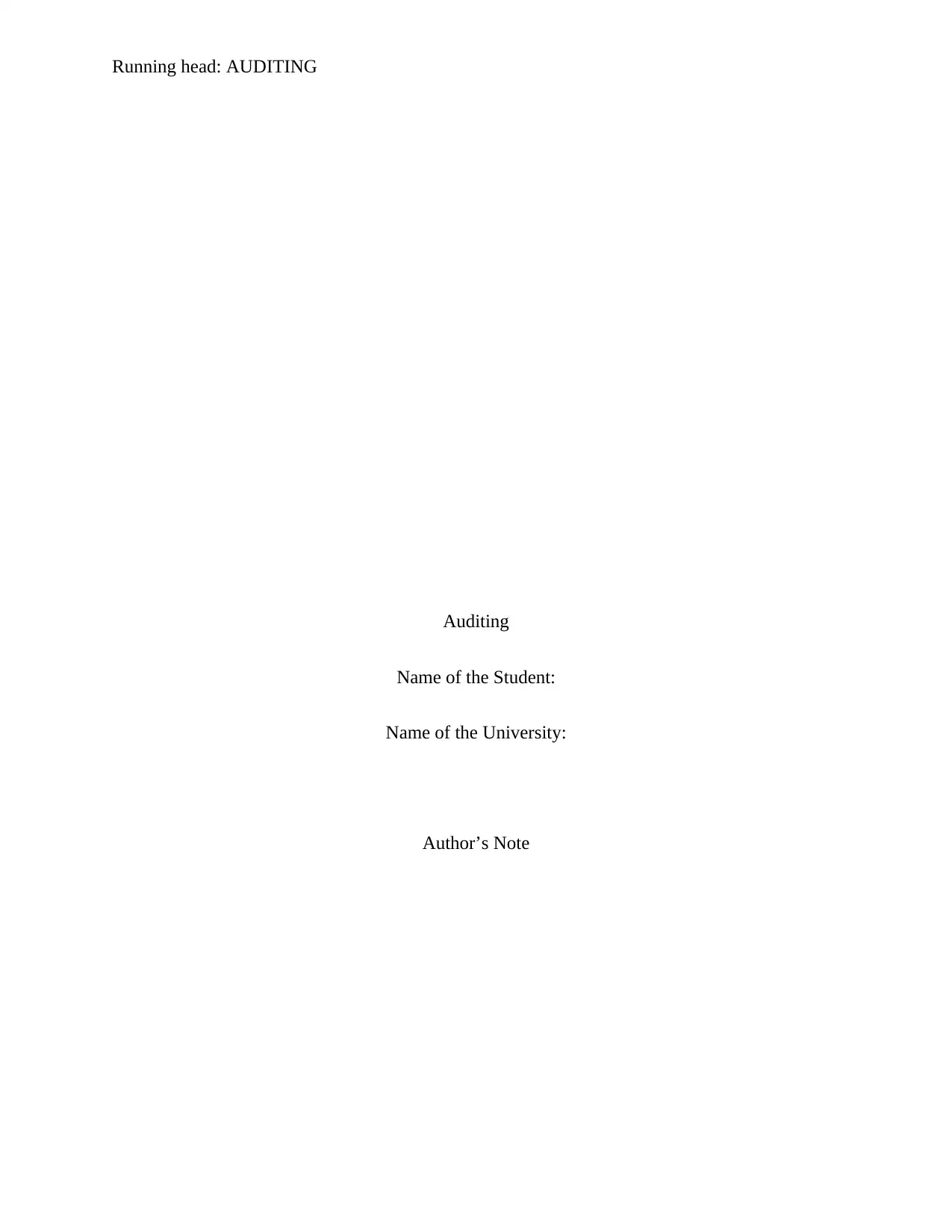
Running head: AUDITING
Auditing
Name of the Student:
Name of the University:
Author’s Note
Auditing
Name of the Student:
Name of the University:
Author’s Note
Paraphrase This Document
Need a fresh take? Get an instant paraphrase of this document with our AI Paraphraser
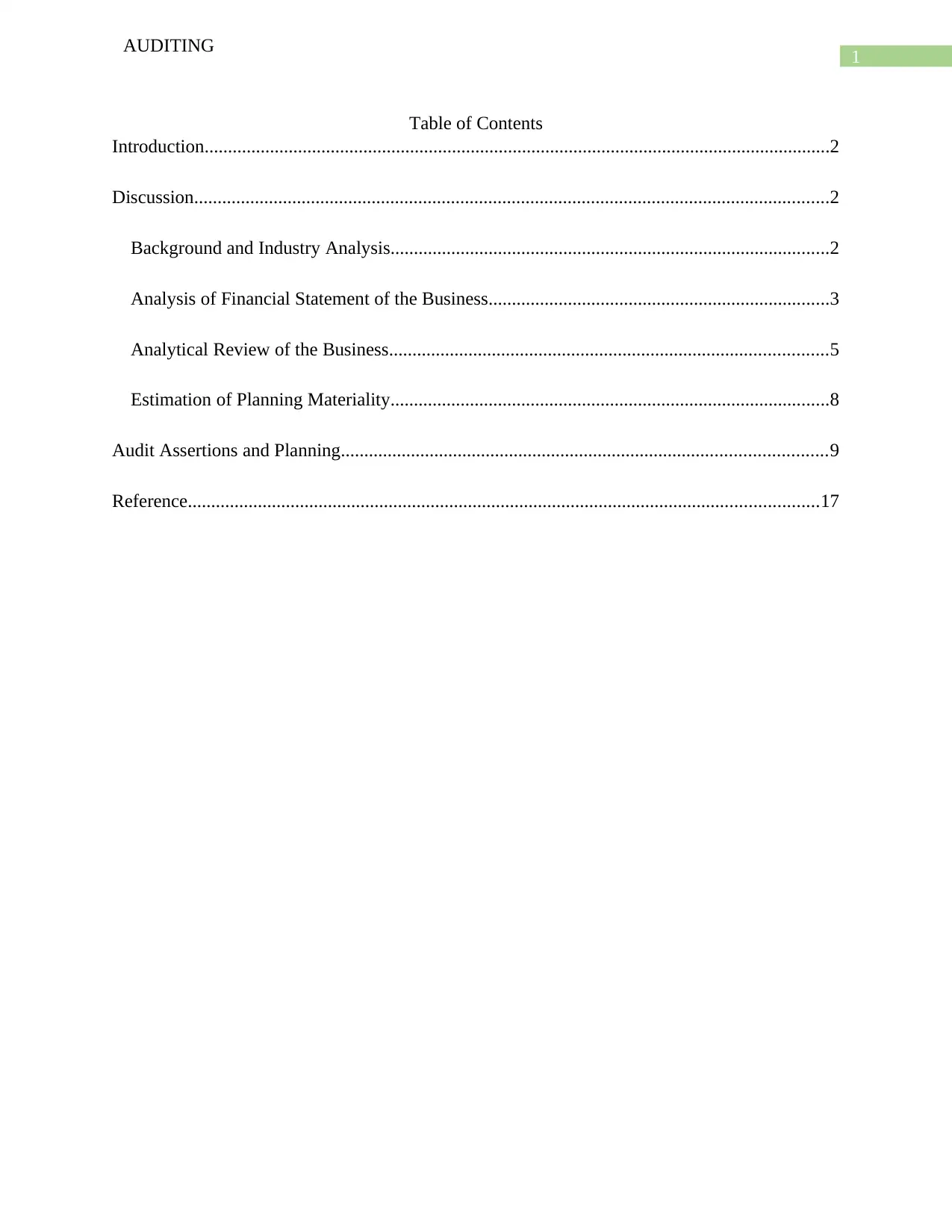
1
AUDITING
Table of Contents
Introduction......................................................................................................................................2
Discussion........................................................................................................................................2
Background and Industry Analysis..............................................................................................2
Analysis of Financial Statement of the Business.........................................................................3
Analytical Review of the Business..............................................................................................5
Estimation of Planning Materiality..............................................................................................8
Audit Assertions and Planning........................................................................................................9
Reference.......................................................................................................................................17
AUDITING
Table of Contents
Introduction......................................................................................................................................2
Discussion........................................................................................................................................2
Background and Industry Analysis..............................................................................................2
Analysis of Financial Statement of the Business.........................................................................3
Analytical Review of the Business..............................................................................................5
Estimation of Planning Materiality..............................................................................................8
Audit Assertions and Planning........................................................................................................9
Reference.......................................................................................................................................17
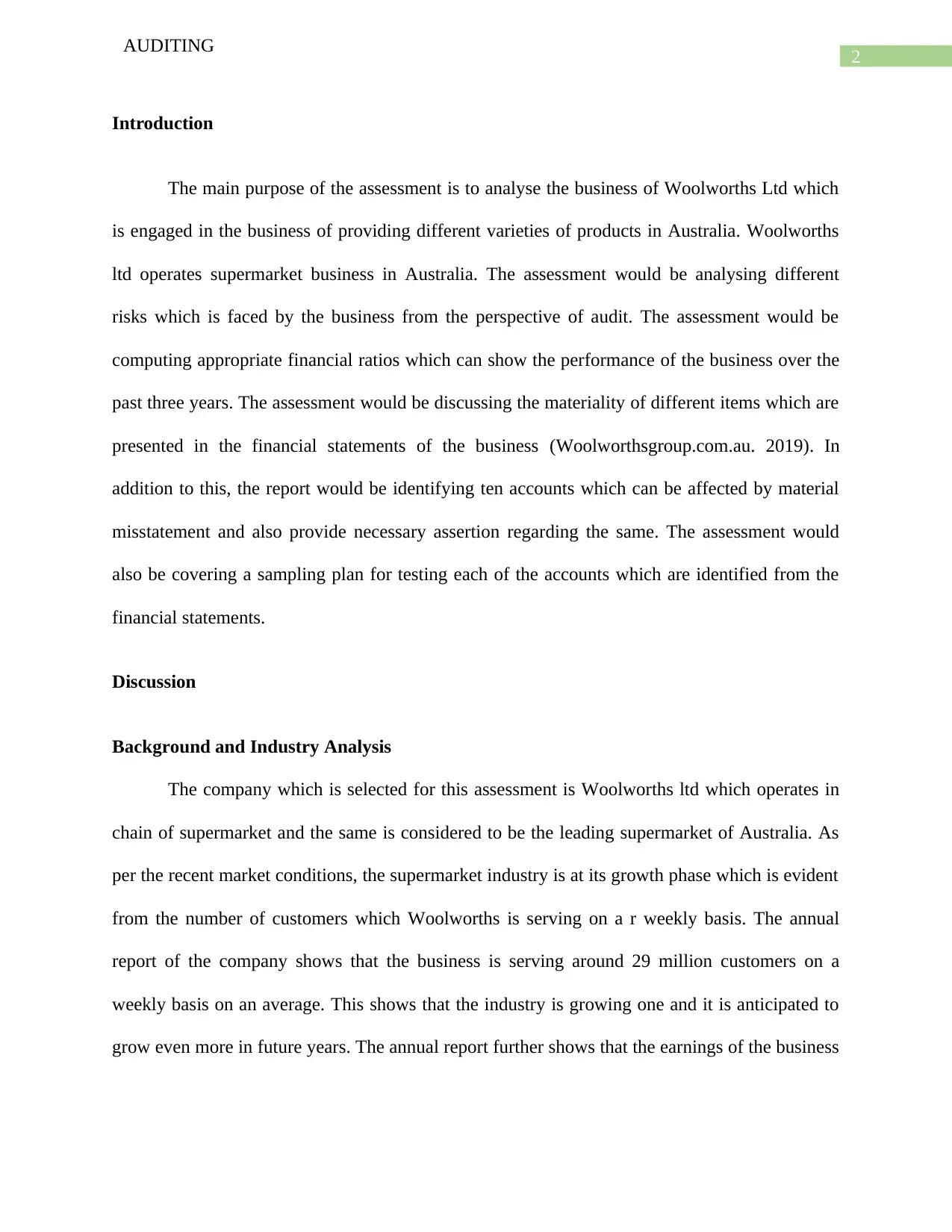
2
AUDITING
Introduction
The main purpose of the assessment is to analyse the business of Woolworths Ltd which
is engaged in the business of providing different varieties of products in Australia. Woolworths
ltd operates supermarket business in Australia. The assessment would be analysing different
risks which is faced by the business from the perspective of audit. The assessment would be
computing appropriate financial ratios which can show the performance of the business over the
past three years. The assessment would be discussing the materiality of different items which are
presented in the financial statements of the business (Woolworthsgroup.com.au. 2019). In
addition to this, the report would be identifying ten accounts which can be affected by material
misstatement and also provide necessary assertion regarding the same. The assessment would
also be covering a sampling plan for testing each of the accounts which are identified from the
financial statements.
Discussion
Background and Industry Analysis
The company which is selected for this assessment is Woolworths ltd which operates in
chain of supermarket and the same is considered to be the leading supermarket of Australia. As
per the recent market conditions, the supermarket industry is at its growth phase which is evident
from the number of customers which Woolworths is serving on a r weekly basis. The annual
report of the company shows that the business is serving around 29 million customers on a
weekly basis on an average. This shows that the industry is growing one and it is anticipated to
grow even more in future years. The annual report further shows that the earnings of the business
AUDITING
Introduction
The main purpose of the assessment is to analyse the business of Woolworths Ltd which
is engaged in the business of providing different varieties of products in Australia. Woolworths
ltd operates supermarket business in Australia. The assessment would be analysing different
risks which is faced by the business from the perspective of audit. The assessment would be
computing appropriate financial ratios which can show the performance of the business over the
past three years. The assessment would be discussing the materiality of different items which are
presented in the financial statements of the business (Woolworthsgroup.com.au. 2019). In
addition to this, the report would be identifying ten accounts which can be affected by material
misstatement and also provide necessary assertion regarding the same. The assessment would
also be covering a sampling plan for testing each of the accounts which are identified from the
financial statements.
Discussion
Background and Industry Analysis
The company which is selected for this assessment is Woolworths ltd which operates in
chain of supermarket and the same is considered to be the leading supermarket of Australia. As
per the recent market conditions, the supermarket industry is at its growth phase which is evident
from the number of customers which Woolworths is serving on a r weekly basis. The annual
report of the company shows that the business is serving around 29 million customers on a
weekly basis on an average. This shows that the industry is growing one and it is anticipated to
grow even more in future years. The annual report further shows that the earnings of the business
⊘ This is a preview!⊘
Do you want full access?
Subscribe today to unlock all pages.

Trusted by 1+ million students worldwide
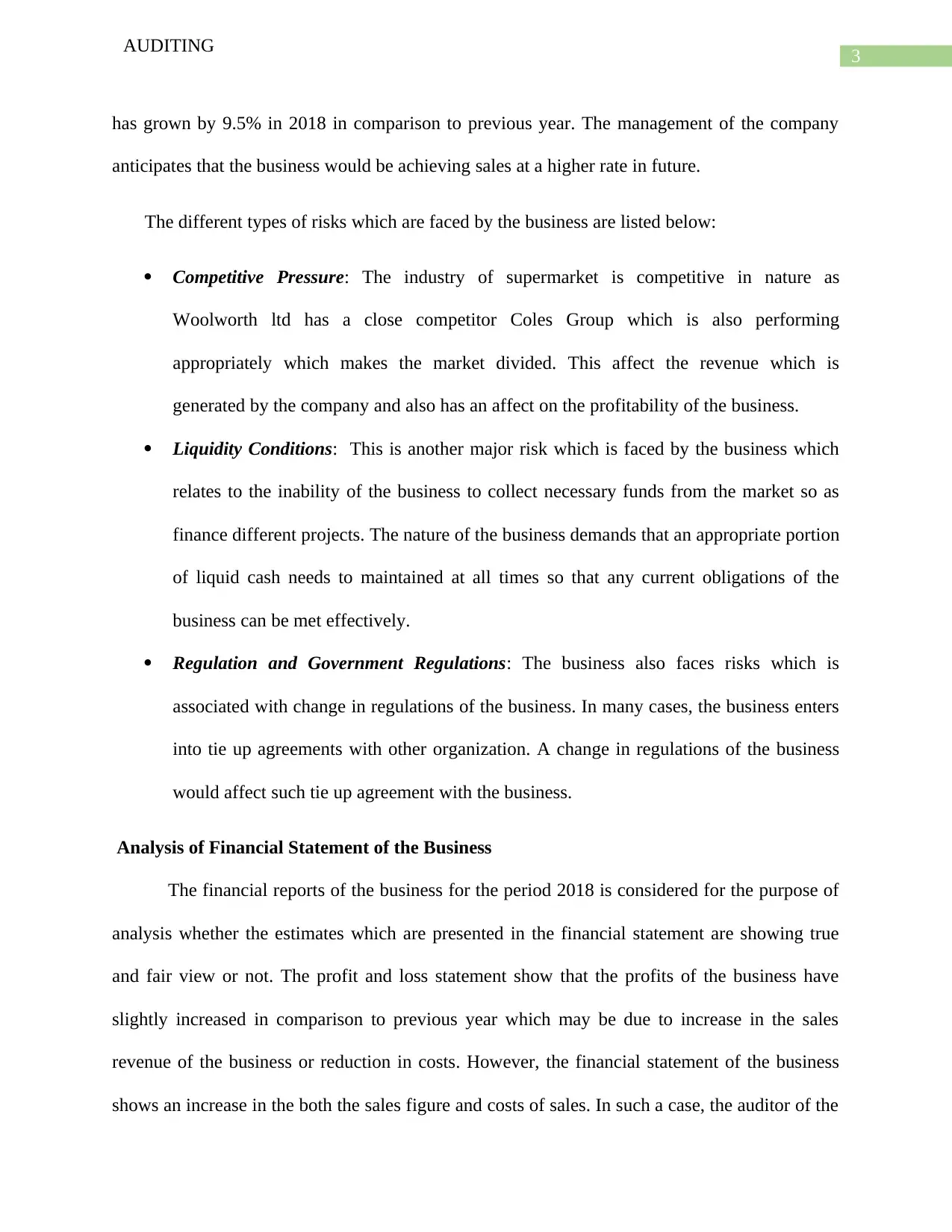
3
AUDITING
has grown by 9.5% in 2018 in comparison to previous year. The management of the company
anticipates that the business would be achieving sales at a higher rate in future.
The different types of risks which are faced by the business are listed below:
Competitive Pressure: The industry of supermarket is competitive in nature as
Woolworth ltd has a close competitor Coles Group which is also performing
appropriately which makes the market divided. This affect the revenue which is
generated by the company and also has an affect on the profitability of the business.
Liquidity Conditions: This is another major risk which is faced by the business which
relates to the inability of the business to collect necessary funds from the market so as
finance different projects. The nature of the business demands that an appropriate portion
of liquid cash needs to maintained at all times so that any current obligations of the
business can be met effectively.
Regulation and Government Regulations: The business also faces risks which is
associated with change in regulations of the business. In many cases, the business enters
into tie up agreements with other organization. A change in regulations of the business
would affect such tie up agreement with the business.
Analysis of Financial Statement of the Business
The financial reports of the business for the period 2018 is considered for the purpose of
analysis whether the estimates which are presented in the financial statement are showing true
and fair view or not. The profit and loss statement show that the profits of the business have
slightly increased in comparison to previous year which may be due to increase in the sales
revenue of the business or reduction in costs. However, the financial statement of the business
shows an increase in the both the sales figure and costs of sales. In such a case, the auditor of the
AUDITING
has grown by 9.5% in 2018 in comparison to previous year. The management of the company
anticipates that the business would be achieving sales at a higher rate in future.
The different types of risks which are faced by the business are listed below:
Competitive Pressure: The industry of supermarket is competitive in nature as
Woolworth ltd has a close competitor Coles Group which is also performing
appropriately which makes the market divided. This affect the revenue which is
generated by the company and also has an affect on the profitability of the business.
Liquidity Conditions: This is another major risk which is faced by the business which
relates to the inability of the business to collect necessary funds from the market so as
finance different projects. The nature of the business demands that an appropriate portion
of liquid cash needs to maintained at all times so that any current obligations of the
business can be met effectively.
Regulation and Government Regulations: The business also faces risks which is
associated with change in regulations of the business. In many cases, the business enters
into tie up agreements with other organization. A change in regulations of the business
would affect such tie up agreement with the business.
Analysis of Financial Statement of the Business
The financial reports of the business for the period 2018 is considered for the purpose of
analysis whether the estimates which are presented in the financial statement are showing true
and fair view or not. The profit and loss statement show that the profits of the business have
slightly increased in comparison to previous year which may be due to increase in the sales
revenue of the business or reduction in costs. However, the financial statement of the business
shows an increase in the both the sales figure and costs of sales. In such a case, the auditor of the
Paraphrase This Document
Need a fresh take? Get an instant paraphrase of this document with our AI Paraphraser
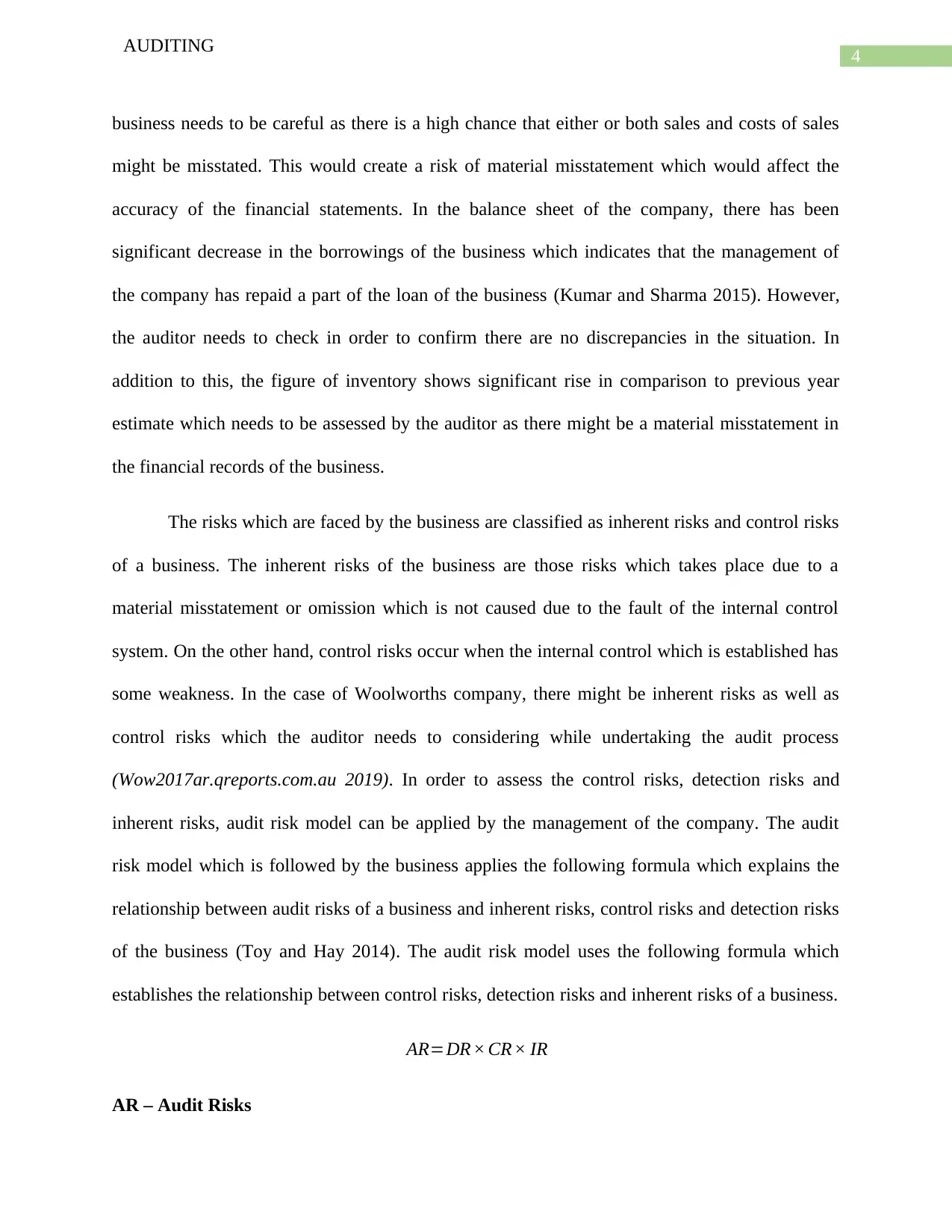
4
AUDITING
business needs to be careful as there is a high chance that either or both sales and costs of sales
might be misstated. This would create a risk of material misstatement which would affect the
accuracy of the financial statements. In the balance sheet of the company, there has been
significant decrease in the borrowings of the business which indicates that the management of
the company has repaid a part of the loan of the business (Kumar and Sharma 2015). However,
the auditor needs to check in order to confirm there are no discrepancies in the situation. In
addition to this, the figure of inventory shows significant rise in comparison to previous year
estimate which needs to be assessed by the auditor as there might be a material misstatement in
the financial records of the business.
The risks which are faced by the business are classified as inherent risks and control risks
of a business. The inherent risks of the business are those risks which takes place due to a
material misstatement or omission which is not caused due to the fault of the internal control
system. On the other hand, control risks occur when the internal control which is established has
some weakness. In the case of Woolworths company, there might be inherent risks as well as
control risks which the auditor needs to considering while undertaking the audit process
(Wow2017ar.qreports.com.au 2019). In order to assess the control risks, detection risks and
inherent risks, audit risk model can be applied by the management of the company. The audit
risk model which is followed by the business applies the following formula which explains the
relationship between audit risks of a business and inherent risks, control risks and detection risks
of the business (Toy and Hay 2014). The audit risk model uses the following formula which
establishes the relationship between control risks, detection risks and inherent risks of a business.
AR=DR × CR× IR
AR – Audit Risks
AUDITING
business needs to be careful as there is a high chance that either or both sales and costs of sales
might be misstated. This would create a risk of material misstatement which would affect the
accuracy of the financial statements. In the balance sheet of the company, there has been
significant decrease in the borrowings of the business which indicates that the management of
the company has repaid a part of the loan of the business (Kumar and Sharma 2015). However,
the auditor needs to check in order to confirm there are no discrepancies in the situation. In
addition to this, the figure of inventory shows significant rise in comparison to previous year
estimate which needs to be assessed by the auditor as there might be a material misstatement in
the financial records of the business.
The risks which are faced by the business are classified as inherent risks and control risks
of a business. The inherent risks of the business are those risks which takes place due to a
material misstatement or omission which is not caused due to the fault of the internal control
system. On the other hand, control risks occur when the internal control which is established has
some weakness. In the case of Woolworths company, there might be inherent risks as well as
control risks which the auditor needs to considering while undertaking the audit process
(Wow2017ar.qreports.com.au 2019). In order to assess the control risks, detection risks and
inherent risks, audit risk model can be applied by the management of the company. The audit
risk model which is followed by the business applies the following formula which explains the
relationship between audit risks of a business and inherent risks, control risks and detection risks
of the business (Toy and Hay 2014). The audit risk model uses the following formula which
establishes the relationship between control risks, detection risks and inherent risks of a business.
AR=DR × CR× IR
AR – Audit Risks
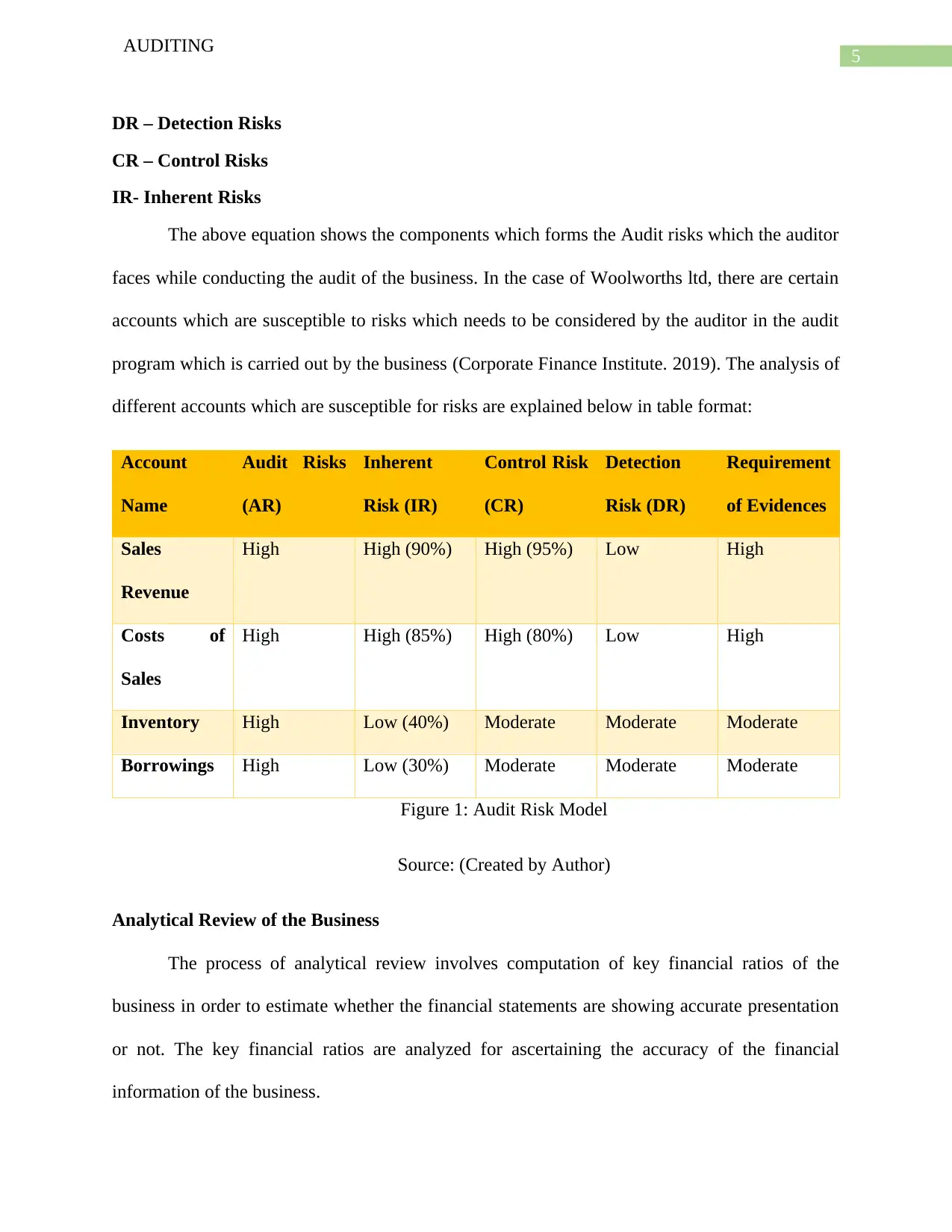
5
AUDITING
DR – Detection Risks
CR – Control Risks
IR- Inherent Risks
The above equation shows the components which forms the Audit risks which the auditor
faces while conducting the audit of the business. In the case of Woolworths ltd, there are certain
accounts which are susceptible to risks which needs to be considered by the auditor in the audit
program which is carried out by the business (Corporate Finance Institute. 2019). The analysis of
different accounts which are susceptible for risks are explained below in table format:
Account
Name
Audit Risks
(AR)
Inherent
Risk (IR)
Control Risk
(CR)
Detection
Risk (DR)
Requirement
of Evidences
Sales
Revenue
High High (90%) High (95%) Low High
Costs of
Sales
High High (85%) High (80%) Low High
Inventory High Low (40%) Moderate Moderate Moderate
Borrowings High Low (30%) Moderate Moderate Moderate
Figure 1: Audit Risk Model
Source: (Created by Author)
Analytical Review of the Business
The process of analytical review involves computation of key financial ratios of the
business in order to estimate whether the financial statements are showing accurate presentation
or not. The key financial ratios are analyzed for ascertaining the accuracy of the financial
information of the business.
AUDITING
DR – Detection Risks
CR – Control Risks
IR- Inherent Risks
The above equation shows the components which forms the Audit risks which the auditor
faces while conducting the audit of the business. In the case of Woolworths ltd, there are certain
accounts which are susceptible to risks which needs to be considered by the auditor in the audit
program which is carried out by the business (Corporate Finance Institute. 2019). The analysis of
different accounts which are susceptible for risks are explained below in table format:
Account
Name
Audit Risks
(AR)
Inherent
Risk (IR)
Control Risk
(CR)
Detection
Risk (DR)
Requirement
of Evidences
Sales
Revenue
High High (90%) High (95%) Low High
Costs of
Sales
High High (85%) High (80%) Low High
Inventory High Low (40%) Moderate Moderate Moderate
Borrowings High Low (30%) Moderate Moderate Moderate
Figure 1: Audit Risk Model
Source: (Created by Author)
Analytical Review of the Business
The process of analytical review involves computation of key financial ratios of the
business in order to estimate whether the financial statements are showing accurate presentation
or not. The key financial ratios are analyzed for ascertaining the accuracy of the financial
information of the business.
⊘ This is a preview!⊘
Do you want full access?
Subscribe today to unlock all pages.

Trusted by 1+ million students worldwide
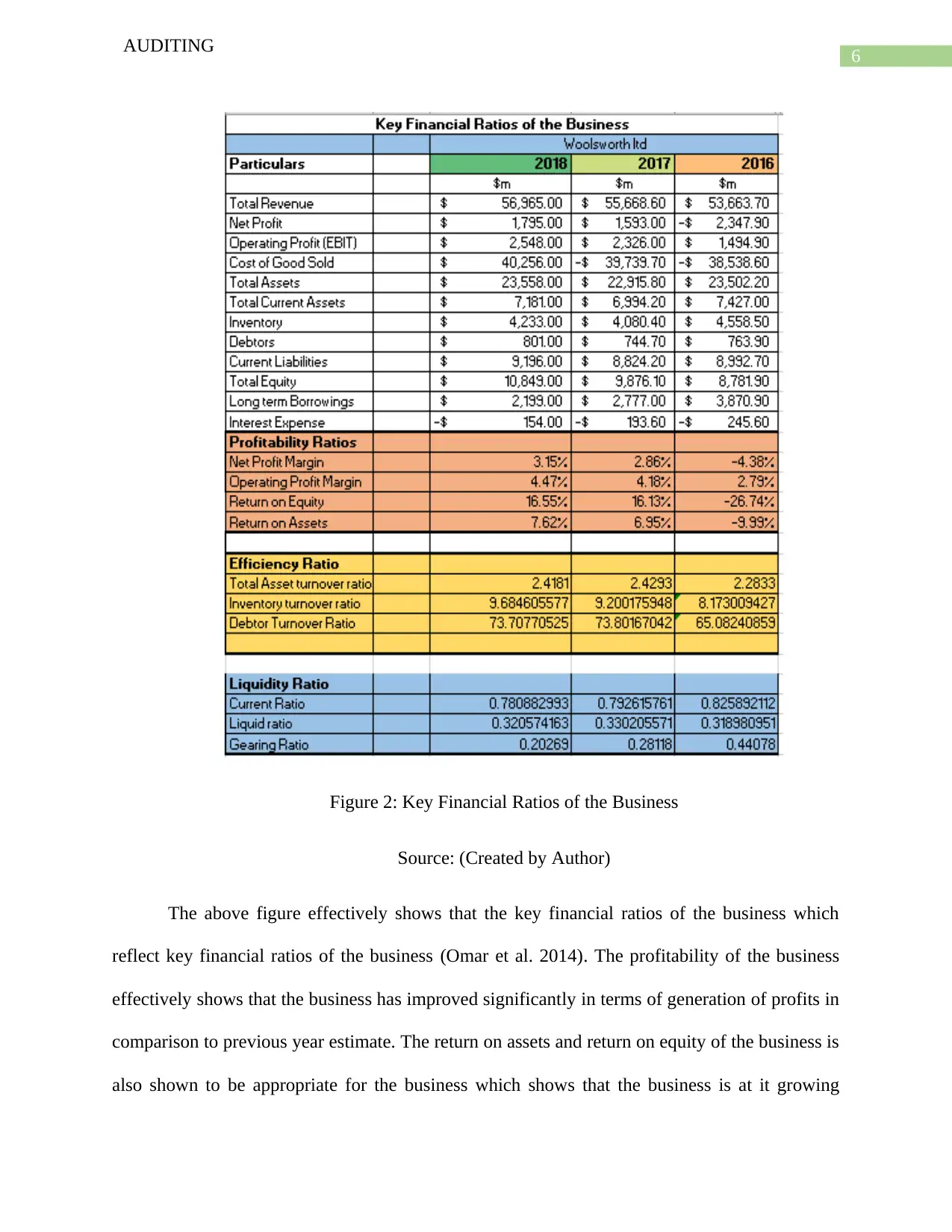
6
AUDITING
Figure 2: Key Financial Ratios of the Business
Source: (Created by Author)
The above figure effectively shows that the key financial ratios of the business which
reflect key financial ratios of the business (Omar et al. 2014). The profitability of the business
effectively shows that the business has improved significantly in terms of generation of profits in
comparison to previous year estimate. The return on assets and return on equity of the business is
also shown to be appropriate for the business which shows that the business is at it growing
AUDITING
Figure 2: Key Financial Ratios of the Business
Source: (Created by Author)
The above figure effectively shows that the key financial ratios of the business which
reflect key financial ratios of the business (Omar et al. 2014). The profitability of the business
effectively shows that the business has improved significantly in terms of generation of profits in
comparison to previous year estimate. The return on assets and return on equity of the business is
also shown to be appropriate for the business which shows that the business is at it growing
Paraphrase This Document
Need a fresh take? Get an instant paraphrase of this document with our AI Paraphraser
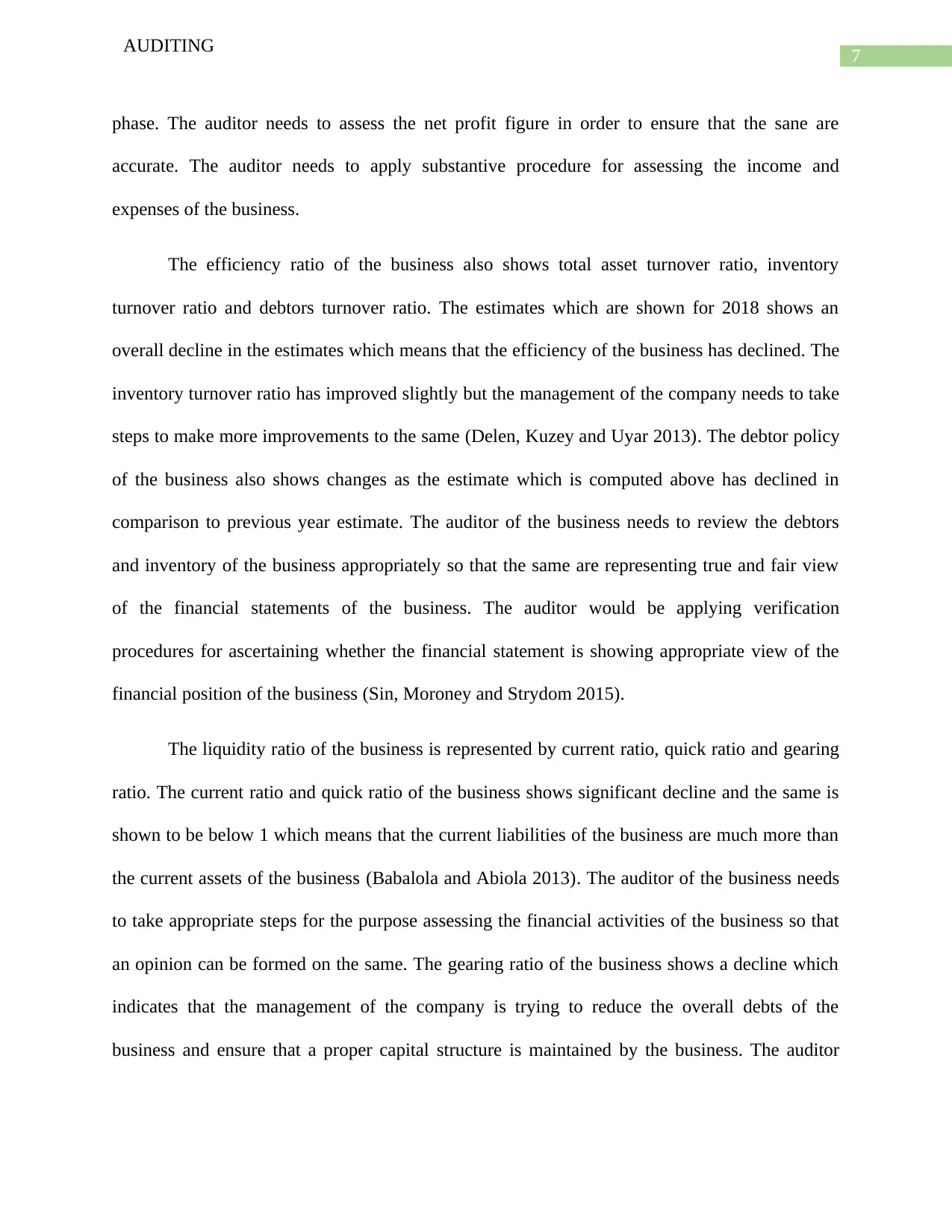
7
AUDITING
phase. The auditor needs to assess the net profit figure in order to ensure that the sane are
accurate. The auditor needs to apply substantive procedure for assessing the income and
expenses of the business.
The efficiency ratio of the business also shows total asset turnover ratio, inventory
turnover ratio and debtors turnover ratio. The estimates which are shown for 2018 shows an
overall decline in the estimates which means that the efficiency of the business has declined. The
inventory turnover ratio has improved slightly but the management of the company needs to take
steps to make more improvements to the same (Delen, Kuzey and Uyar 2013). The debtor policy
of the business also shows changes as the estimate which is computed above has declined in
comparison to previous year estimate. The auditor of the business needs to review the debtors
and inventory of the business appropriately so that the same are representing true and fair view
of the financial statements of the business. The auditor would be applying verification
procedures for ascertaining whether the financial statement is showing appropriate view of the
financial position of the business (Sin, Moroney and Strydom 2015).
The liquidity ratio of the business is represented by current ratio, quick ratio and gearing
ratio. The current ratio and quick ratio of the business shows significant decline and the same is
shown to be below 1 which means that the current liabilities of the business are much more than
the current assets of the business (Babalola and Abiola 2013). The auditor of the business needs
to take appropriate steps for the purpose assessing the financial activities of the business so that
an opinion can be formed on the same. The gearing ratio of the business shows a decline which
indicates that the management of the company is trying to reduce the overall debts of the
business and ensure that a proper capital structure is maintained by the business. The auditor
AUDITING
phase. The auditor needs to assess the net profit figure in order to ensure that the sane are
accurate. The auditor needs to apply substantive procedure for assessing the income and
expenses of the business.
The efficiency ratio of the business also shows total asset turnover ratio, inventory
turnover ratio and debtors turnover ratio. The estimates which are shown for 2018 shows an
overall decline in the estimates which means that the efficiency of the business has declined. The
inventory turnover ratio has improved slightly but the management of the company needs to take
steps to make more improvements to the same (Delen, Kuzey and Uyar 2013). The debtor policy
of the business also shows changes as the estimate which is computed above has declined in
comparison to previous year estimate. The auditor of the business needs to review the debtors
and inventory of the business appropriately so that the same are representing true and fair view
of the financial statements of the business. The auditor would be applying verification
procedures for ascertaining whether the financial statement is showing appropriate view of the
financial position of the business (Sin, Moroney and Strydom 2015).
The liquidity ratio of the business is represented by current ratio, quick ratio and gearing
ratio. The current ratio and quick ratio of the business shows significant decline and the same is
shown to be below 1 which means that the current liabilities of the business are much more than
the current assets of the business (Babalola and Abiola 2013). The auditor of the business needs
to take appropriate steps for the purpose assessing the financial activities of the business so that
an opinion can be formed on the same. The gearing ratio of the business shows a decline which
indicates that the management of the company is trying to reduce the overall debts of the
business and ensure that a proper capital structure is maintained by the business. The auditor
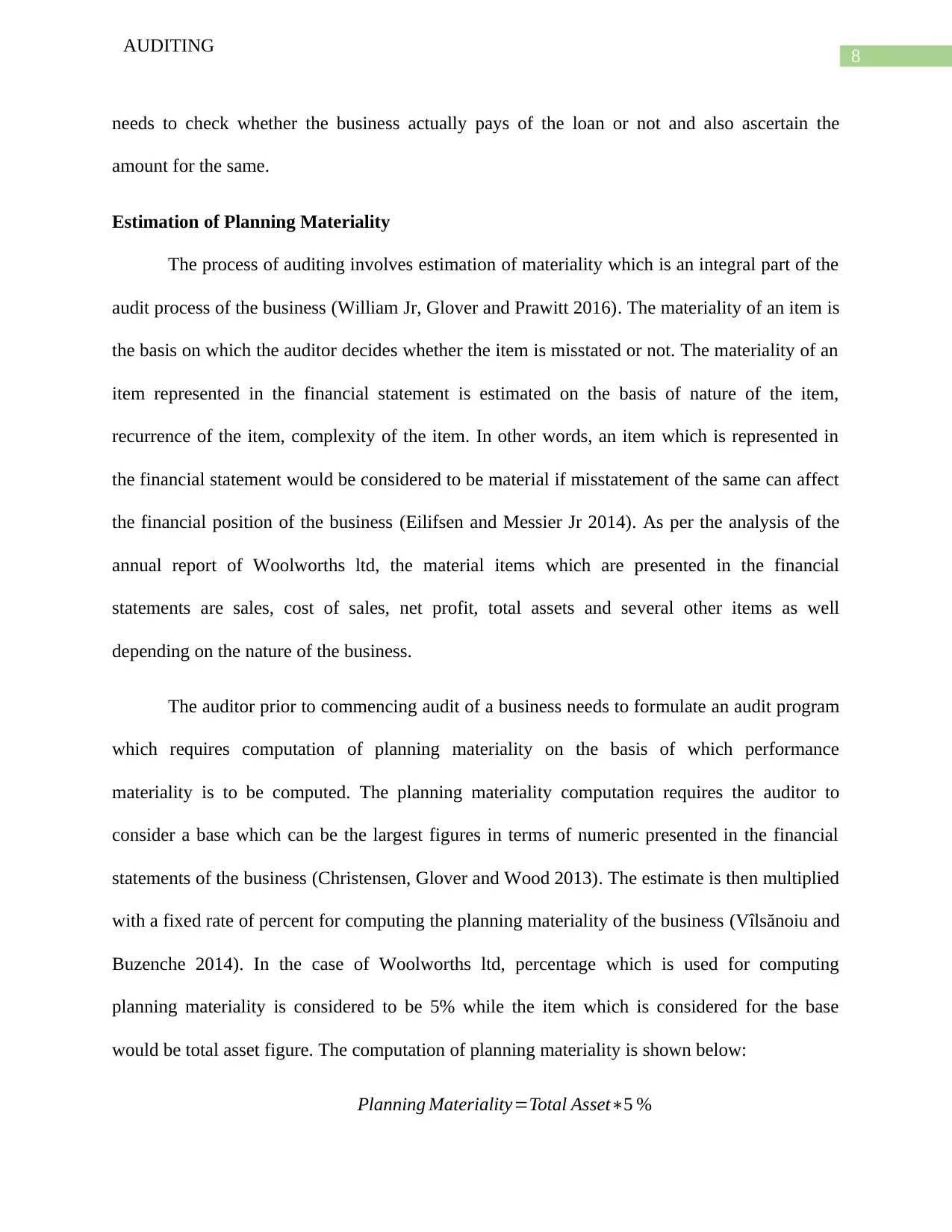
8
AUDITING
needs to check whether the business actually pays of the loan or not and also ascertain the
amount for the same.
Estimation of Planning Materiality
The process of auditing involves estimation of materiality which is an integral part of the
audit process of the business (William Jr, Glover and Prawitt 2016). The materiality of an item is
the basis on which the auditor decides whether the item is misstated or not. The materiality of an
item represented in the financial statement is estimated on the basis of nature of the item,
recurrence of the item, complexity of the item. In other words, an item which is represented in
the financial statement would be considered to be material if misstatement of the same can affect
the financial position of the business (Eilifsen and Messier Jr 2014). As per the analysis of the
annual report of Woolworths ltd, the material items which are presented in the financial
statements are sales, cost of sales, net profit, total assets and several other items as well
depending on the nature of the business.
The auditor prior to commencing audit of a business needs to formulate an audit program
which requires computation of planning materiality on the basis of which performance
materiality is to be computed. The planning materiality computation requires the auditor to
consider a base which can be the largest figures in terms of numeric presented in the financial
statements of the business (Christensen, Glover and Wood 2013). The estimate is then multiplied
with a fixed rate of percent for computing the planning materiality of the business (Vîlsănoiu and
Buzenche 2014). In the case of Woolworths ltd, percentage which is used for computing
planning materiality is considered to be 5% while the item which is considered for the base
would be total asset figure. The computation of planning materiality is shown below:
Planning Materiality=Total Asset∗5 %
AUDITING
needs to check whether the business actually pays of the loan or not and also ascertain the
amount for the same.
Estimation of Planning Materiality
The process of auditing involves estimation of materiality which is an integral part of the
audit process of the business (William Jr, Glover and Prawitt 2016). The materiality of an item is
the basis on which the auditor decides whether the item is misstated or not. The materiality of an
item represented in the financial statement is estimated on the basis of nature of the item,
recurrence of the item, complexity of the item. In other words, an item which is represented in
the financial statement would be considered to be material if misstatement of the same can affect
the financial position of the business (Eilifsen and Messier Jr 2014). As per the analysis of the
annual report of Woolworths ltd, the material items which are presented in the financial
statements are sales, cost of sales, net profit, total assets and several other items as well
depending on the nature of the business.
The auditor prior to commencing audit of a business needs to formulate an audit program
which requires computation of planning materiality on the basis of which performance
materiality is to be computed. The planning materiality computation requires the auditor to
consider a base which can be the largest figures in terms of numeric presented in the financial
statements of the business (Christensen, Glover and Wood 2013). The estimate is then multiplied
with a fixed rate of percent for computing the planning materiality of the business (Vîlsănoiu and
Buzenche 2014). In the case of Woolworths ltd, percentage which is used for computing
planning materiality is considered to be 5% while the item which is considered for the base
would be total asset figure. The computation of planning materiality is shown below:
Planning Materiality=Total Asset∗5 %
⊘ This is a preview!⊘
Do you want full access?
Subscribe today to unlock all pages.

Trusted by 1+ million students worldwide
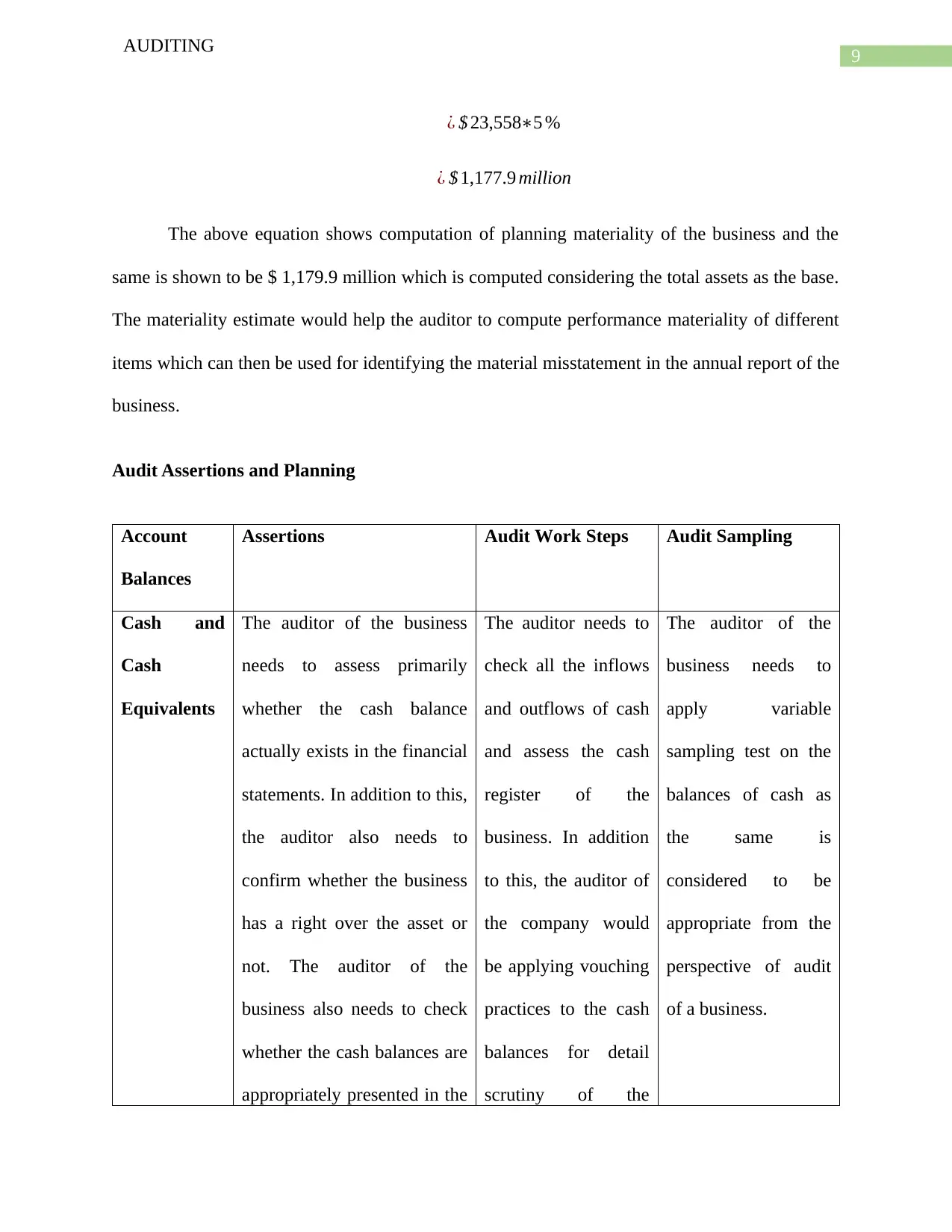
9
AUDITING
¿ $ 23,558∗5 %
¿ $ 1,177.9 million
The above equation shows computation of planning materiality of the business and the
same is shown to be $ 1,179.9 million which is computed considering the total assets as the base.
The materiality estimate would help the auditor to compute performance materiality of different
items which can then be used for identifying the material misstatement in the annual report of the
business.
Audit Assertions and Planning
Account
Balances
Assertions Audit Work Steps Audit Sampling
Cash and
Cash
Equivalents
The auditor of the business
needs to assess primarily
whether the cash balance
actually exists in the financial
statements. In addition to this,
the auditor also needs to
confirm whether the business
has a right over the asset or
not. The auditor of the
business also needs to check
whether the cash balances are
appropriately presented in the
The auditor needs to
check all the inflows
and outflows of cash
and assess the cash
register of the
business. In addition
to this, the auditor of
the company would
be applying vouching
practices to the cash
balances for detail
scrutiny of the
The auditor of the
business needs to
apply variable
sampling test on the
balances of cash as
the same is
considered to be
appropriate from the
perspective of audit
of a business.
AUDITING
¿ $ 23,558∗5 %
¿ $ 1,177.9 million
The above equation shows computation of planning materiality of the business and the
same is shown to be $ 1,179.9 million which is computed considering the total assets as the base.
The materiality estimate would help the auditor to compute performance materiality of different
items which can then be used for identifying the material misstatement in the annual report of the
business.
Audit Assertions and Planning
Account
Balances
Assertions Audit Work Steps Audit Sampling
Cash and
Cash
Equivalents
The auditor of the business
needs to assess primarily
whether the cash balance
actually exists in the financial
statements. In addition to this,
the auditor also needs to
confirm whether the business
has a right over the asset or
not. The auditor of the
business also needs to check
whether the cash balances are
appropriately presented in the
The auditor needs to
check all the inflows
and outflows of cash
and assess the cash
register of the
business. In addition
to this, the auditor of
the company would
be applying vouching
practices to the cash
balances for detail
scrutiny of the
The auditor of the
business needs to
apply variable
sampling test on the
balances of cash as
the same is
considered to be
appropriate from the
perspective of audit
of a business.
Paraphrase This Document
Need a fresh take? Get an instant paraphrase of this document with our AI Paraphraser
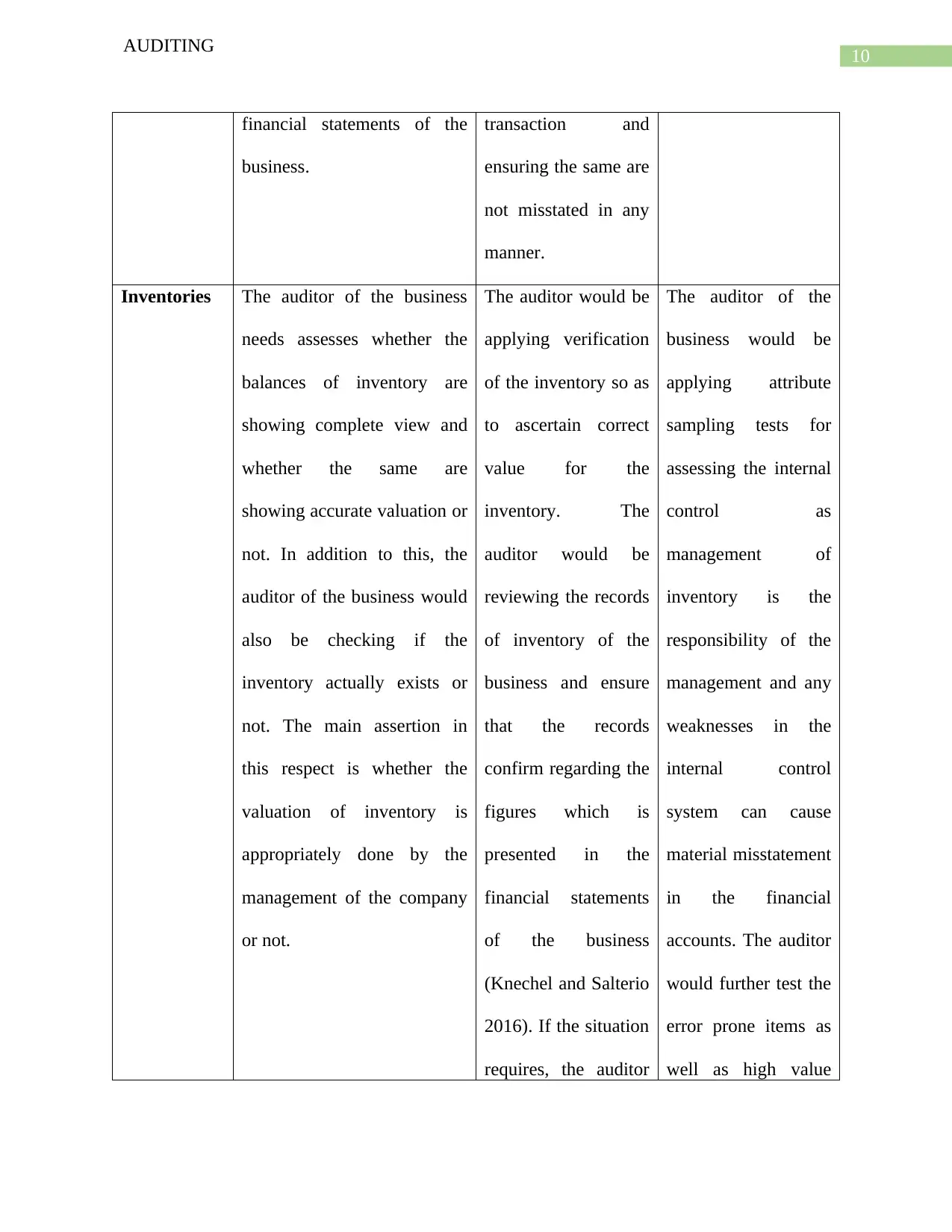
10
AUDITING
financial statements of the
business.
transaction and
ensuring the same are
not misstated in any
manner.
Inventories The auditor of the business
needs assesses whether the
balances of inventory are
showing complete view and
whether the same are
showing accurate valuation or
not. In addition to this, the
auditor of the business would
also be checking if the
inventory actually exists or
not. The main assertion in
this respect is whether the
valuation of inventory is
appropriately done by the
management of the company
or not.
The auditor would be
applying verification
of the inventory so as
to ascertain correct
value for the
inventory. The
auditor would be
reviewing the records
of inventory of the
business and ensure
that the records
confirm regarding the
figures which is
presented in the
financial statements
of the business
(Knechel and Salterio
2016). If the situation
requires, the auditor
The auditor of the
business would be
applying attribute
sampling tests for
assessing the internal
control as
management of
inventory is the
responsibility of the
management and any
weaknesses in the
internal control
system can cause
material misstatement
in the financial
accounts. The auditor
would further test the
error prone items as
well as high value
AUDITING
financial statements of the
business.
transaction and
ensuring the same are
not misstated in any
manner.
Inventories The auditor of the business
needs assesses whether the
balances of inventory are
showing complete view and
whether the same are
showing accurate valuation or
not. In addition to this, the
auditor of the business would
also be checking if the
inventory actually exists or
not. The main assertion in
this respect is whether the
valuation of inventory is
appropriately done by the
management of the company
or not.
The auditor would be
applying verification
of the inventory so as
to ascertain correct
value for the
inventory. The
auditor would be
reviewing the records
of inventory of the
business and ensure
that the records
confirm regarding the
figures which is
presented in the
financial statements
of the business
(Knechel and Salterio
2016). If the situation
requires, the auditor
The auditor of the
business would be
applying attribute
sampling tests for
assessing the internal
control as
management of
inventory is the
responsibility of the
management and any
weaknesses in the
internal control
system can cause
material misstatement
in the financial
accounts. The auditor
would further test the
error prone items as
well as high value
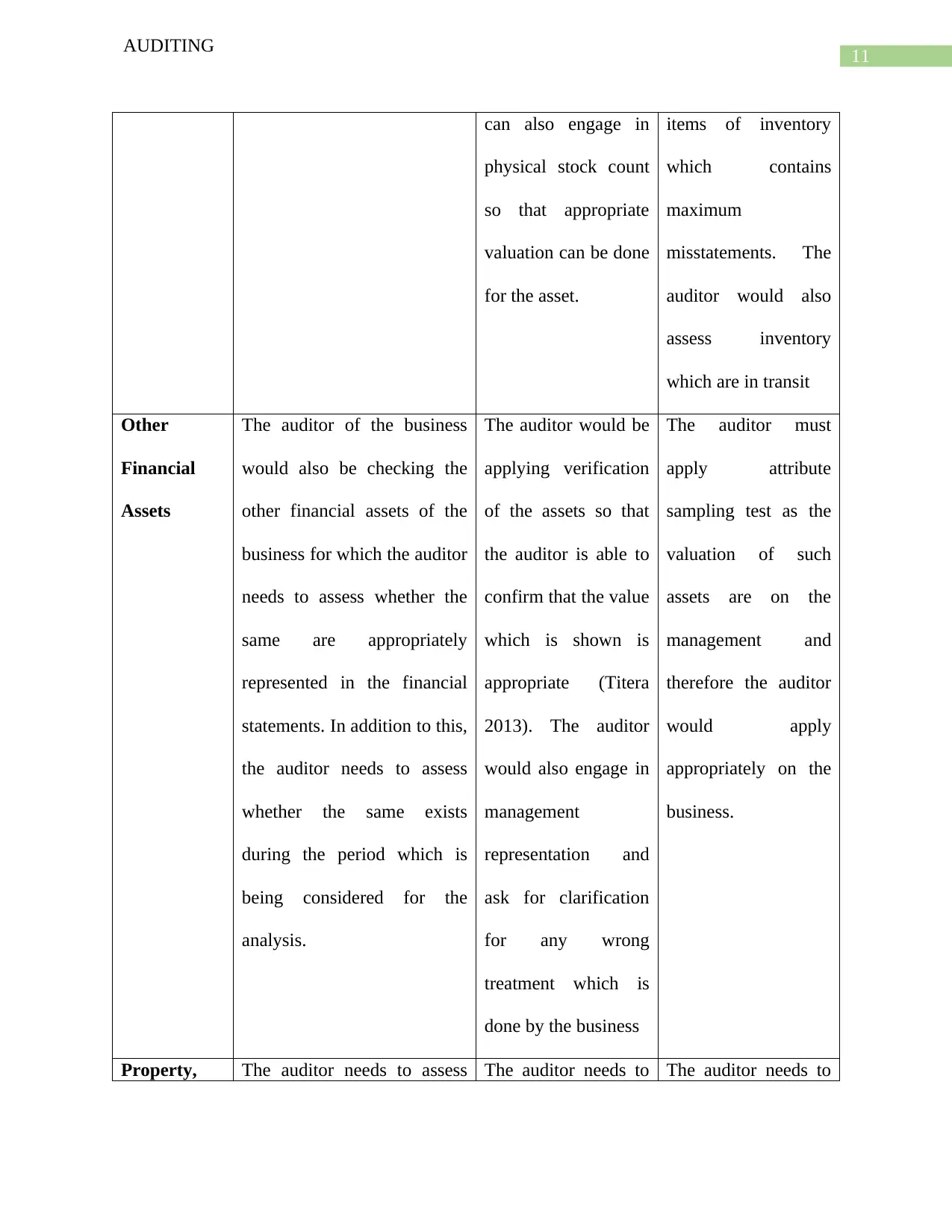
11
AUDITING
can also engage in
physical stock count
so that appropriate
valuation can be done
for the asset.
items of inventory
which contains
maximum
misstatements. The
auditor would also
assess inventory
which are in transit
Other
Financial
Assets
The auditor of the business
would also be checking the
other financial assets of the
business for which the auditor
needs to assess whether the
same are appropriately
represented in the financial
statements. In addition to this,
the auditor needs to assess
whether the same exists
during the period which is
being considered for the
analysis.
The auditor would be
applying verification
of the assets so that
the auditor is able to
confirm that the value
which is shown is
appropriate (Titera
2013). The auditor
would also engage in
management
representation and
ask for clarification
for any wrong
treatment which is
done by the business
The auditor must
apply attribute
sampling test as the
valuation of such
assets are on the
management and
therefore the auditor
would apply
appropriately on the
business.
Property, The auditor needs to assess The auditor needs to The auditor needs to
AUDITING
can also engage in
physical stock count
so that appropriate
valuation can be done
for the asset.
items of inventory
which contains
maximum
misstatements. The
auditor would also
assess inventory
which are in transit
Other
Financial
Assets
The auditor of the business
would also be checking the
other financial assets of the
business for which the auditor
needs to assess whether the
same are appropriately
represented in the financial
statements. In addition to this,
the auditor needs to assess
whether the same exists
during the period which is
being considered for the
analysis.
The auditor would be
applying verification
of the assets so that
the auditor is able to
confirm that the value
which is shown is
appropriate (Titera
2013). The auditor
would also engage in
management
representation and
ask for clarification
for any wrong
treatment which is
done by the business
The auditor must
apply attribute
sampling test as the
valuation of such
assets are on the
management and
therefore the auditor
would apply
appropriately on the
business.
Property, The auditor needs to assess The auditor needs to The auditor needs to
⊘ This is a preview!⊘
Do you want full access?
Subscribe today to unlock all pages.

Trusted by 1+ million students worldwide
1 out of 20
Related Documents
Your All-in-One AI-Powered Toolkit for Academic Success.
+13062052269
info@desklib.com
Available 24*7 on WhatsApp / Email
![[object Object]](/_next/static/media/star-bottom.7253800d.svg)
Unlock your academic potential
Copyright © 2020–2025 A2Z Services. All Rights Reserved. Developed and managed by ZUCOL.



